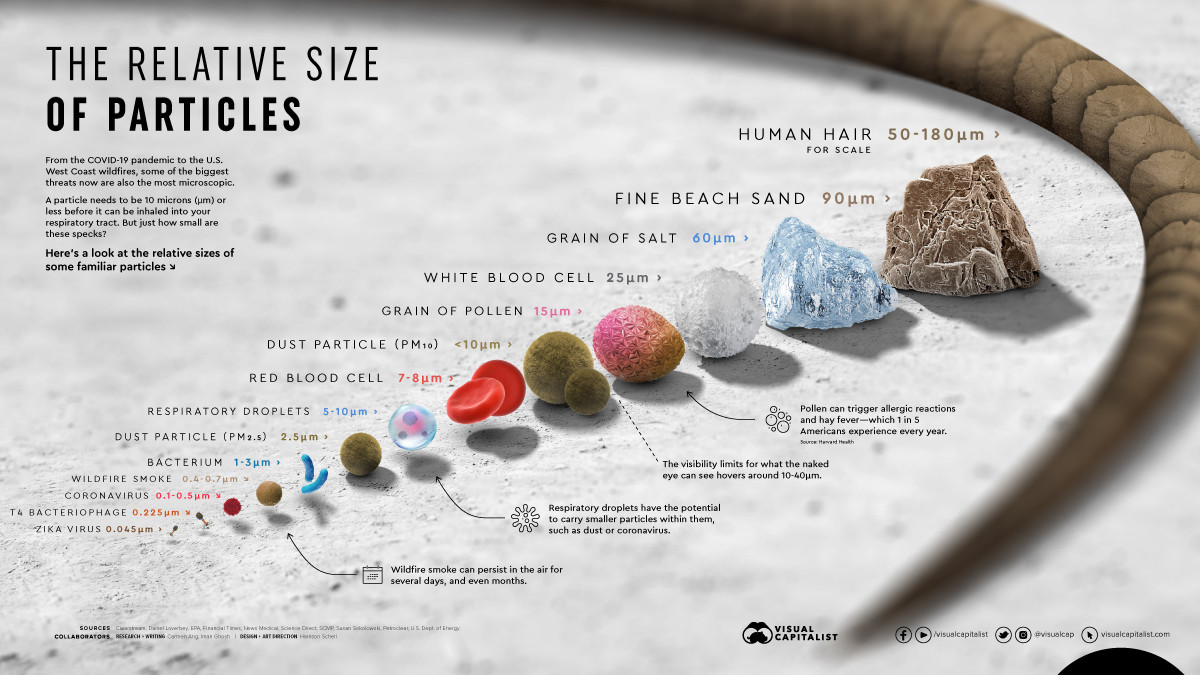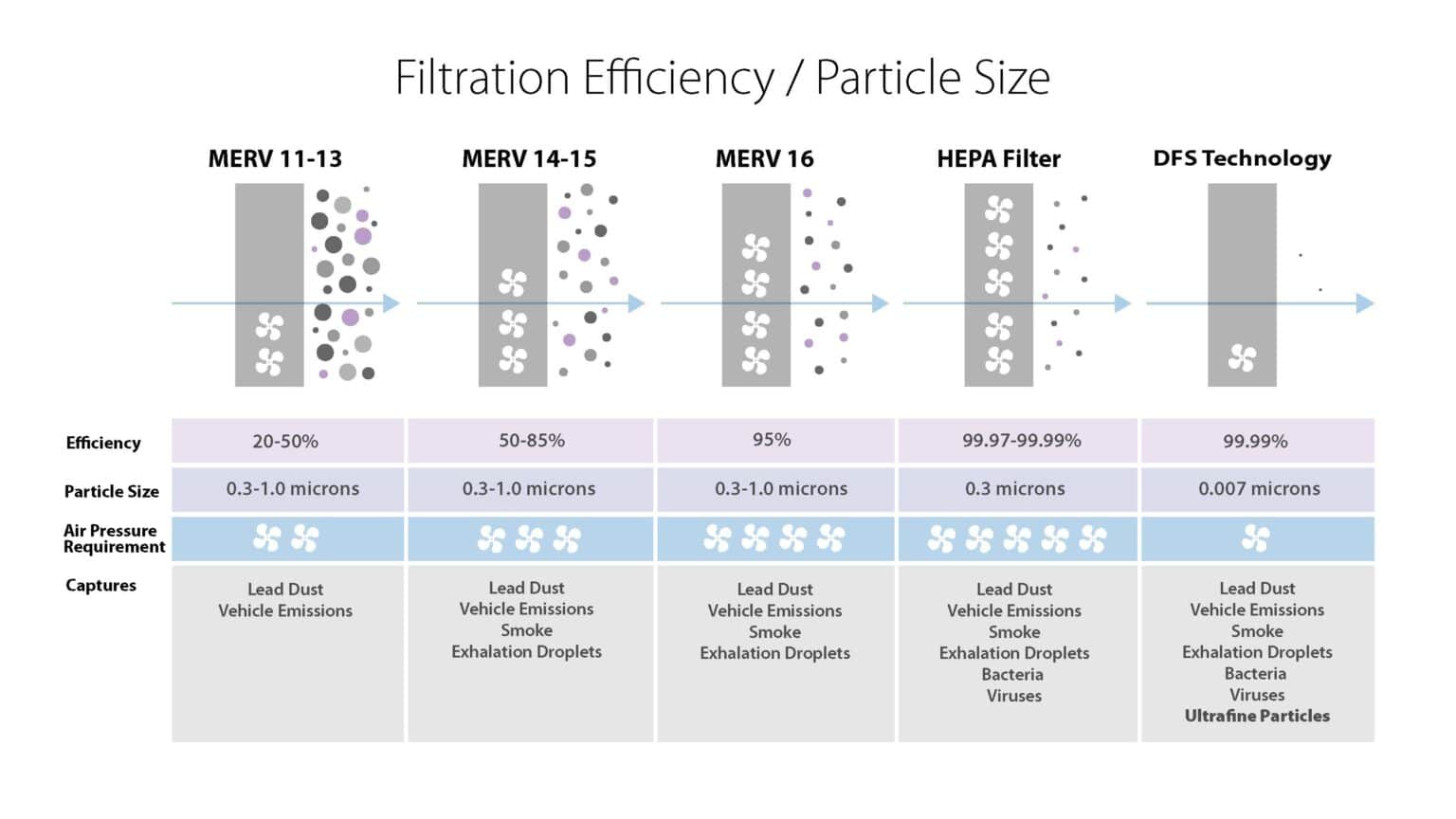Having clean air is vital to good health and when it comes to cleaning the air around you, it's about more than bad smells. Apart from those who may be sensitive to respiratory concerns, using an at home or in the office air purifier has gone from a nice-to-have to a need-to-have.
Air purification technology has evolved over years and are now common in hospitals, schools, office buildings, or even in a home. Explaining the difference between HEPA, ULPA, and DFS is a good place to start to understand how some of the most popular filters and machines work to clean your air.
The alphabet soup that has developed includes some of these terms you might be familiar with:
- IAQ or Indoor Air Quality - A simple measurement of the amount of particulate relative to the air volume measured in PPM (parts per million).
- HEPA or High-Efficiency Particulate Air - A filter standard that is rated to remove 99.97% of particles 0.3µm in size.
- ULPA or Ultra Low Particulate Air- Efficiency rating: 99.999% removal of airborne particles 0.12µm in size.
- DFS or Disinfecting Filtration System – Proprietary Intellipure technology tested to remove 99.97% of particles 0.007µm in size.

Table of Contents
2. Harmful pollutants that aren't considered particulate matter.
4. HEPA and ULPA similarities and differences.
dfs">5. What is DFS technology?
7. Round-up: What is the most effective filter between HEPA, ULPA, and DFS?
1. What are HEPA filters?
HEPA stands for "high-efficiency particulate air” (filter). A HEPA filter is a mesh-like sheet of dense interwoven synthetic or glass fibers. This type of air filter has a standard to remove at least 99.97% of dust, pollen, mold, bacteria, and any airborne particles with a size of 0.3 microns (µm). The diameter specification of 0.3 microns corresponds to the worst case; the most penetrating particle size (MPPS).
2. Harmful pollutants that aren’t considered particulate matter.
VOCs: Volatile Organic Compounds
VOCs are emitted as gasses from certain solids or liquids. VOCs include a variety of chemicals, some of which may have short- and long-term health effects. VOCs can be up to 10x higher indoors than outdoors. They are often components of petroleum fuels, hydraulic fluids, paint thinners, and other cleaning products found in your home and workplace. These VOCs compounds are small enough to pass through a HEPA filter back into the air, so it is recommended to have a VOC prefilter within your air purifier.
Bacteria
Bacteria can grow and build up on filters causing microorganisms to collect on the filter. This can be a breeding ground for bacterial toxins, also known as endotoxins. Bacterial toxins can get back into the air if they are small enough to pass through the filter. Some bacterial toxins are linked to health problems like coronary artery disease, cystic fibrosis, and autoimmune diseases.
Mold
Although large mold spores can be caught by a filter, they also can live on and in the filter. This can cause the mold spores to gather, reproduce, and potentially get released back into the air.
Viruses
Viruses come in many different sizes, some are smaller than 0.03 microns. While some filters can capture viruses depending on the size, they don’t necessarily destroy the virus once in the filter. This gives them the potential to escape back out into the air.
3. What are ULPA filters?
Another filter people often come across is a ULPA filter (Ultra Low Particulate Air), which is commonly confused with a HEPA filter. ULPA filters claim to remove 99.999% at 0.12 microns.
Similarities And Differences Between HEPA And ULPA
- HEPA and ULPA filters are made of similar materials that allow air to pass through them and trap airborne particles.
- Both filters have a similar, although slightly different, construction but the air filtration process is the same.
- HEPA and ULPA filters cannot generally remove odors or gasses from the air.
- While ULPA filters tend to remove smaller particles than HEPA filters do, ULPA filters restrict more airflow, meaning they will give you fewer air changes per hour at a given pressure drop.
5. What is DFS technology?
Disinfecting Filtration System (DFS) technology sends the air first through an energy grid that charges the air and prevents anything from living or growing inside the filter. Charged air passes through a filter where any remaining particulate is captured down to 0.007 microns.
DFS achieves total system efficiency, meaning our products are tested to achieve at or greater than 99.97% efficiency at 0.3 microns at the unit level. We test our products to ensure they eliminate filter bypass. DFS technology has gone through many rigorous third-party testing experiments and can be relied upon to capture and remove harmful viruses, mold, fungi, bacteria, and ultra-fine particles leaving nothing but fresh, pure, healthy air inside your space.
How does DFS work?
- The DFS high energy field inside each Intellipure air purifier creates a self‐contained, highly energized state in the main HEPA filter that clusters ultrafine particles to make them larger, allowing the main filter to effectively capture ultrafine particles.
- The DFS continually creates high-energy exposure through the pleats and fibers of the main HEPA filter. This prevents organism growth in the main filter and maintains a high level of capture.
6. How long does each filter type last?
-
HEPA and ULPA Filters
Another common misconception about HEPA filters is how often they need to be replaced. On average, these filters are recommended to be replaced every 3-6 months based on the usage and the filter type.
DFS Filters
Intellipure filters last long because of the DFS technology. With proper maintenance and adherence to filter replacement schedules, your Intellipure air purifier will fill your home with the cleanest air possible for longer.
Click here to learn more about DFS technology and filters
Intellipure air purifiers with DFS remove the smallest particles, are affordable to maintain, and give peace of mind that you are breathing the cleanest air possible.
ASHRAE guidelines have recommended installing the highest achievable MERV-rated filter to best address the likelihood of airborne transmission of viruses. Our Whole Home Solution achieves greater than MERV16 efficiency, with the pressure drop of a MERV 8, and can be installed without major capital expenditure. It also has a substantially longer and higher performance life cycle.
The Environmental Protection Agency (EPA) recommends eliminating the source of pollution when possible. By using technology like DFS, you’re taking harmful particles out of the air and helping to reduce your risk of developing these long-term illnesses.

High-Performance Portable Air Purifiers
Explore plug-and-play solutions for your space that meet or exceed the HEPA standard.
-
Sale!

Compact Air Purifier
Up to 500 sq ft
Original price was: $299.00.$159.00Current price is: $159.00.
Add to cart
-
Sale!

Ultrafine 468 Air Purifier – White
Up to 1,200 sq ft
Original price was: $999.00.$449.00Current price is: $449.00.
Add to cart
-
Sale!

Ultrafine 468 Air Purifier - Black
Up to 1,200 sq ft
Original price was: $999.00.$499.00Current price is: $499.00.
Add to cart
Intellipure®
We’re reimagining the world as a better, safer place with innovative air purification technologies. Our solutions are engineered in the USA and trusted everywhere #AirQualityMatters. To find out more about the latest in clean air, take a look at the Intellipure lineup or follow us on Instagram at @Intellipure.

